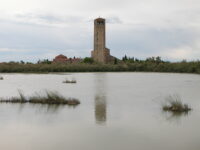 The Basilica of Santa Maria Assunta on the Venetian Lagoon island of Torcello is famed for its spectacular 11th century mosaics, rivalling those in its much larger neighbor, St Mark’s Basilica in Venice. In fact, the original 11th century mosaics in the interior of St. Mark’s were largely lost in a fire that ravaged the city in 1106, while many of Santa Maria’s original mosaics are still extant making them the earliest surviving mosaics in greater Venice.
The Basilica of Santa Maria Assunta on the Venetian Lagoon island of Torcello is famed for its spectacular 11th century mosaics, rivalling those in its much larger neighbor, St Mark’s Basilica in Venice. In fact, the original 11th century mosaics in the interior of St. Mark’s were largely lost in a fire that ravaged the city in 1106, while many of Santa Maria’s original mosaics are still extant making them the earliest surviving mosaics in greater Venice.
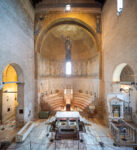 The central apse mosaic features the Virgin Hodegetria (a Byzantine iconographic motif of Mary pointing to the Christ Child as savior) against a glowing background of gold tiles. Below her are a line of saints. Christ Pantacrator (Christ in Majesty) sits enthroned on the diaconicon apse, while above him the Evangelists hold up a medallion of the Lamb of God. The west wall is covered roof to floor with registers of mosaics. The top register in the gable of the roof is a Crucifixion. Below that a large figure of Christ strides through a scene of the Anastasis (Harrowing of Hell). Below that are four tiers depicting the Last Judgment. The design and materials are of the highest quality. The works were likely made by Byzantine mosaicists.
The central apse mosaic features the Virgin Hodegetria (a Byzantine iconographic motif of Mary pointing to the Christ Child as savior) against a glowing background of gold tiles. Below her are a line of saints. Christ Pantacrator (Christ in Majesty) sits enthroned on the diaconicon apse, while above him the Evangelists hold up a medallion of the Lamb of God. The west wall is covered roof to floor with registers of mosaics. The top register in the gable of the roof is a Crucifixion. Below that a large figure of Christ strides through a scene of the Anastasis (Harrowing of Hell). Below that are four tiers depicting the Last Judgment. The design and materials are of the highest quality. The works were likely made by Byzantine mosaicists.
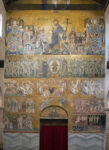 Conservation and research in the late 1970s found evidence of a major restoration of the church’s apse and west wall after an earthquake in the second half of the 12th century. The figure of Mary in the apse appears to have been heavily restored at this time, but the mosaicists who did the repairs used the same materials and techniques as their predecessors making the restoration basically invisible to the naked eye. It was only identified in 1975 because conservators erected full scaffolding and examined the mosaics literally inch by inch.
Conservation and research in the late 1970s found evidence of a major restoration of the church’s apse and west wall after an earthquake in the second half of the 12th century. The figure of Mary in the apse appears to have been heavily restored at this time, but the mosaicists who did the repairs used the same materials and techniques as their predecessors making the restoration basically invisible to the naked eye. It was only identified in 1975 because conservators erected full scaffolding and examined the mosaics literally inch by inch.
Torcello’s history predates the existence of Venice. The small spit of land north of Murano was the first island in the Venetian Lagoon to be inhabited. According to a 10th century chronicle, Torcello was settled in 452 by ![]() refugees from Altinum, a town on the mainland shore, fleeing the destruction of their city by Attila the Hun. This account is not supported by the evidence, however. For one thing, Altinum continued to be populated for centuries after Attila and the Lombard invasions a hundred years after him. For another, remains of Roman villas going back to the 2nd century A.D. have been found on Torcello. There is also no archaeological indication of a large population shift in the mid-5th century; rather, the island appears to have been gradually colonized from Roman imperial times onwards.
refugees from Altinum, a town on the mainland shore, fleeing the destruction of their city by Attila the Hun. This account is not supported by the evidence, however. For one thing, Altinum continued to be populated for centuries after Attila and the Lombard invasions a hundred years after him. For another, remains of Roman villas going back to the 2nd century A.D. have been found on Torcello. There is also no archaeological indication of a large population shift in the mid-5th century; rather, the island appears to have been gradually colonized from Roman imperial times onwards.
Its location on a fluvial channel that led through the lagoon to the open sea made it convenient for the small shipping concerns that thrived after the demise of the large imperial ports on the mainland. The little island also proved fertile ground and vineyards and orchards thrived during the late Roman and Byzantine eras. Defensive embankments were built around the island starting in the 7th century to protect it from flooding, drawing even more people and trade.
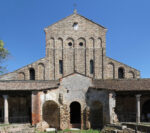 The first inscription recording human settlement of the Venetian Lagoon dates to that period. It notes the construction of the cathedral on Torcello in 639 by order of Isaac, Exarch of Ravenna, under the reign of the Byzantine Emperor Heraclius. It was a single aisle structure that was enlarged into a three-aisled church in the 9th century and took its present form three-aisled form with high vaults decorated in mosaics in the 11th century. Significant parts of the 7th century church have survived, making the basilica the oldest standing structure in the Venetian Lagoon.
The first inscription recording human settlement of the Venetian Lagoon dates to that period. It notes the construction of the cathedral on Torcello in 639 by order of Isaac, Exarch of Ravenna, under the reign of the Byzantine Emperor Heraclius. It was a single aisle structure that was enlarged into a three-aisled church in the 9th century and took its present form three-aisled form with high vaults decorated in mosaics in the 11th century. Significant parts of the 7th century church have survived, making the basilica the oldest standing structure in the Venetian Lagoon.
The island prospered and grew, developing industries that included the production of salt, wool and glass. While the Rivo Alto islet that would become the Rialto/Venice was still a scrappy upstart, Torcello had a population of 20,000. Venice would come into its own in the 11th century, and its rise paralleled Torcello’s eventual decline. By the 14th century its industry was dead and by the time the Republic of Venice fell to Napoleon in 1797, there were only 300 residents on the island. Today there are 11, guards and guides for Torcello’s cultural patrimony.
When Venice was flooded by record-breaking high tides in November and December 2019, Torcello was hit hard. It is a flat islet, so the salt waters of the lagoon don’t have to rise very high to flood it, and once they have, the waters take longer to recede than they do elsewhere on the lagoon. The basilica’s mosaic stone floors and brick and mortar walls absorb the salt water so it causes damage to the structure far beyond the high water mark.
![]() The American non-profit organization Save Venice, which has been living up to its name since 1971, raising funds to repair hundreds of Venice’s most important sites, had already begun to work on a rescue project for Santa Maria’s walls and mosaics. Conservators had been on site for just a month when the floods struck leaving a huge emergency cleanup to contend with. Save Venice partnered with the Embassy of Italy in Washington, D.C., to launch the Immediate Response Fund which provided emergency funds to Torcello and 22 other sites in Venice damaged by the floods.
The American non-profit organization Save Venice, which has been living up to its name since 1971, raising funds to repair hundreds of Venice’s most important sites, had already begun to work on a rescue project for Santa Maria’s walls and mosaics. Conservators had been on site for just a month when the floods struck leaving a huge emergency cleanup to contend with. Save Venice partnered with the Embassy of Italy in Washington, D.C., to launch the Immediate Response Fund which provided emergency funds to Torcello and 22 other sites in Venice damaged by the floods.
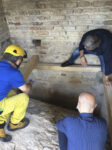 Once the water subsided, with the collaboration of the diocese of Venice and the Università Ca’ Foscari, conservators began work on more than 2,400 square feet of Byzantine mosaics inside Santa Maria Assunta. With 1300+ years of earthquakes, floods and just plain salt marsh living, the bricks are subject to crumbling and the mortar is loose. In order to ensure the survival of the church and the mosaics attached to said walls, for every section of the mosaic that is conserved, the interior and exterior brick and stonework have to be stabilized at the same time.
Once the water subsided, with the collaboration of the diocese of Venice and the Università Ca’ Foscari, conservators began work on more than 2,400 square feet of Byzantine mosaics inside Santa Maria Assunta. With 1300+ years of earthquakes, floods and just plain salt marsh living, the bricks are subject to crumbling and the mortar is loose. In order to ensure the survival of the church and the mosaics attached to said walls, for every section of the mosaic that is conserved, the interior and exterior brick and stonework have to be stabilized at the same time.
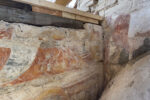 When the team was examining the vault of the diaconicon chapel, they removed a small rectangle of the roof to look down inside and assess the stability of the vault. They saw some red paint and realized they had found frescoes that predated the construction of the high vault and mosaics in the early 11th century.
When the team was examining the vault of the diaconicon chapel, they removed a small rectangle of the roof to look down inside and assess the stability of the vault. They saw some red paint and realized they had found frescoes that predated the construction of the high vault and mosaics in the early 11th century.
Two surviving narrative scenes can be distinguished, one on each side wall. With the help of palaeographical evidence from two fragmentary inscriptions, the archaeologist Diego Calaon and his team have dated the murals to the middle of the ninth century. The first wall painting, which survives in an especially damaged state, depicts a scene from the life of
the fourth-century bishop St Martin of Tours (the inscription reads ‘[San]c[tu]s Martinus’). The scene from the life of the Virgin Mary (‘[M]ar[ia]’) on the opposite wall is in somewhat better condition. We can get a sense of the style of the master, who painted the face of the Virgin in a rough but expressive manner. Scholars have frequently argued that Venetian artists preferred other mediums to mural painting given the unfavourable climatic conditions. However, the wall paintings at Torcello suggest that the tradition of mural painting appeared early on in the Venetian lagoon.
They also offer a rare glimpse into the artistic development of the lagoon before it was completely dominated by Venice. Extensive archaeological research conducted over the last few decades in Comacchio, Altino, and Torcello has significantly advanced our understanding of the early economic development and the changing dynamics of power in the Adriatic. In the eighth and ninth centuries, the Venetian lagoon emerged as an important economic and commercial hub, with Byzantine and Carolingian agents competing for influence. Discussion of Torcello has tended to focus on its Byzantine connections, owing to the supposed foundation of Santa Maria Assunta by a Byzantine exarch and its 11th-century mosaics – but these wall paintings suggest that greater attention is due to Torcello’s connections with the Carolingian hinterland.
The fresco of St. Martin is culturally significant because it is one of the earliest representations of the saint (the earliest is in Ravenna and dates to the 6th century). It’s also a scene not often found in St. Martin iconography. There are two saints together, and since we know one is Martin, the other could be his mentor St. Hilary. It suggests the fresco could have been part of a cycle of scenes from the life of St. Martin.
In the Merovingian and Carolingian era St Martin’s cloak became an important symbol of power, serving as the royal military banner. The wall painting at Torcello might show us new ways to understand how the tendrils of Carolingian influence in the Venetian lagoon reached not only into the spheres of economics and politics, but also devotional networks.
The mural featuring the Virgin Mary may be an Annunciation. There is an unidentifiable figure to her left and a servant girl to her right.
This detail is not unusual in Carolingian imagery and served to emphasise the Virgin’s noble status as a matrona. While this feature appears only rarely after the Carolingian period, the Visitation mosaic of San Marco attests to its survival in around 1200. Such a small yet meaningful similarity between the two images prompts further investigation into artistic ties between Torcello and Venice over the longue durée. The newly discovered murals in Torcello not only add a new dimension to ongoing discussions about Byzantine and Carolingian competition in the north Adriatic, but open fresh lines of enquiry into the early artistic development of Venice and the lagoon.
Here is a fantastic webinar about the restoration of the mosaics and the discovery of the frescoes in the basilica hosted by Save Venice.
Yes, “leading the way”. The ‘Hodos’ bit was clear to me, but I had to look up the ‘Getria’ part:
ὁδός / hodos (“Way”) and ἡγέομαι / (and its present middle infinitive) ἡγεῖσθαι / hegeisthai (“to lead”), cf. the term ‘hegemony’ derived from ἡγεμονία.
PS: The ‘Royal Frankish Annals’ note for 806AD:
“Niceta patricius, qui cum classe Constantinopolitana sedebat in Venetia, pace facta cum Pippino rege [Pepin of Italy, obviously] et indutiis usque ad mensem Augustum constitutis statione soluta Constantinopolim regressus est.” 😆
Marvellous, amazing and many other similar adjectives, what would I do to be there now!
Wonderful! I visited Torcello and the church on my first visit to Venice many years ago. I do hope I can go back in the not too distant future!